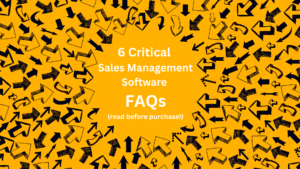Valsoft Acquires WeSuite to Enter Sales Management Software Space
Valsoft Corporation Enters the Sales Management Software Space with the
Great sales people know that including an executive summary as part of a proposal makes a huge difference in distinguishing them from the rest. Let’s start by talking about the purpose of an executive summary and continue with the key elements to be certain to include.

The Purpose of an Executive Summary
The Executive Summary is a high-level paragraph or two summarizing why you and your solution meets or exceeds the specific needs of the customer for the project. It is the reason they should buy from you. The Executive Summary is written and designed for key decision makers, who may not be deep into the project details however, understand why the project is important to the organization. These are the people who typically will flip directly to your price, skipping all the other fluffy proposal stuff.
A good Executive Summary solidifies his or her agreement that you are the one and when really well done, provokes these readers to want to know more than just the “bottom line”.
Essential executive summary elements include:
The Solution Statement
The opening statement for the Executive Summary is one that provides the reader what they came for: what you specifically are committing to do for me. The statement is probably one of most difficult aspects of writing a good executive summary. You will write it, re-read and edit it several times. Each time moving toward the most clear and concise solution summary statement you can provide.
There are several keys to a creating a great solution statement.
The solution statement is more about them than it is about you. Think about you and your products and services from their perspective. Understanding their top 3 priorities and how you help them to achieve success for these is essential to articulating the solution statement.
Adding Value
Every sales person out there brags about their great customer service, top manufacturer lines, stellar installation team, years in business, etc., etc. You need to be sure you don’t fall in line! Tackling a single way you and your company add value specific to them and their needs, now and into the future, is different.
Think about the prospect or customer’s top 3-5 priorities related to why they are doing this project and how you will help them to achieve these. If you have identified the single most important reason they are under going the work, show how you can specifically help to bolster and achieve this goal. They are looking for real value. Value that is important to them and their needs. In today’s world, buyers have plenty of information about you and your competition, as well as available solutions long before you enter the picture. Dig in to find out what is at the heart of what they need. Create your value statement around this. Then prove it!
Thought Provoking
The final element may be the toughest. Your executive statement must include an idea, concept, statement or question, so meaningful to them, that it piques their interest in a way that invites you for deeper discussion and real consideration. It separates buying for price – the other guys – from buying from you. This seed is a tease that pulls the reader in to actually really consider you as different. It is further proven out in the remainder of your proposal document. The presentation of the scope of work, the technical solution and presentation.
Of course, ultimately the reader will go to the price. (Hopefully you took care of the budget and required investment long before presenting your proposal!). Using an Executive Summary as the first stop before flipping to that pricing page, will give the key decision makers reason to look beyond price and into the real value you and your team bring to the table.
The sales relationship is, first and foremost, about the client and his or her needs – not about you. When first meeting with a prospect, make sure to ask lots of questions to understand the challenges they face, and make clear that you understand their pain. Turning a sales prospect into a client involves displaying empathy and creative thinking.
Start each conversation with an open mind—no preconceived notions—so that valuable time isn’t wasted focusing on the wrong things. Meaningful questions can help the customer paint a picture of his or her office or facility, the problems that need solving, and the priority order for solving them. Also probe for budget and required timeline.
The best salespeople make a concerted effort to get inside the head of the customer and, unless you’re a magical mind-reader, that can only happen with a lot of Q&A. Once there, you can really understand the full range of issues that must be addressed and begin developing options that ring true.
Your company may serve a wide range of markets and have clients from large to small. That record can help establish your credibility, but ultimately, new customers want to know that your experience, and the solution you’re offering, is just right for them.
Even if the systems you’re recommending are relatively turn-key, be sure to explain how they can be set up and customized to cater to the customer’s specific needs. Together, agree on what would work well to achieve their particular goals. Just like a top-quality off-the-rack suit fits better with a little custom tailoring, the same goes for security technology. Let the customer help define the specifics of what the systems needs to do, so that together, you can decide how to leverage the technology to make that happen.
Develop a plan together as you walk through the facility, providing guidance and seeking customer buy-in throughout the process. Today’s app-based floor plan tools can be a huge help with this. Using photos, schematics, maps or floor plans imported into a tablet or laptop, you and the customer can walk their site, jointly identify locations for cameras, access control readers and other components, dragging them into place as you go. Some apps also let you make detailed notes about issues or concerns.
Talk about how the solution you’re designing together would affect users’ routines, and how managers would operate and maintain the system. You might also address remote administrative use, user-friendliness, and other issues. The goal here is that by the time the customer receives your proposal, he or she is convinced that the value your company offers extends beyond the technology you’ll install. It’s the peace-of-mind that your solution has been designed with a true understanding of how it will be used, managed and maintained over time.
Writing down additional notes, following any walk-through, about special considerations that should be incorporated into your quote. If something was a priority for the customer, highlighting it in your proposal could give your company the winning edge.
To aid with this process, some sales management apps allow users to record notes directly into the customer file through dictation over their mobile device, via a text-to-talk function. This allows note taking to happen quickly and easily from the parking lot, between appointments, instead of at the end of the day when conversations may blur together and are no longer fresh in your mind.
When it’s time to present a proposal, remember that the individual(s) you met with may not be the only stakeholders involved in the selection process. The insights you gained in jointly developing a plan must be on full display to all who review the proposal. Show ‘em what you learned!
Lead with an executive summary that hits the customer’s pain points and explains how you will address them. Reiterate the key concerns the customer has expressed so that the entire decision-making team appreciates the depth to which you understand their security objectives.
Back up the “meat” of your proposal with specifics that further demonstrate your attention to detail and knowledge of the site. Include those floorplans of the system design you worked on together, along with relevant notes. And be sure to present pricing options that respect the client’s budgets. If he or she has expressed concern about upfront costs, lead with financing options or a phased installation that places higher priority systems at the beginning of the queue. Your goal is to make your contact … the person you’ve been working with up until this point … a “hero” in the eyes of fellow stakeholders. Make it clear that because they have represented the business’s needs and expectations well, you have been able to deliver a proposal that’s on the mark in every respect.
The Payoff – Your Sale Becomes an “Inside Job”
When a customer has skin in the game, when they feel that your proposal is best representing their own understanding of how their company’s security should be addressed, they’ve joined your team.
If two competing proposals have made the final cut, the solution that the customer feels more personally invested in will almost always win out. They’ve already spent time thinking about it, visualizing it and taking ownership of it. Of course, that’s the system they’ll prefer! By taking an active collaborative selling approach, you can ensure that that system is your system!
Valsoft Corporation Enters the Sales Management Software Space with the

I love connecting with great salespeople and getting their top tips on selling. Here are 3 great tips from Rapid Response’s Neil Riveron…

In the market for sales estimating software? Read this before purchase!…

Want to know how sales estimating software is a great sales coaching tool? Read on.
Subscribe to our blog!